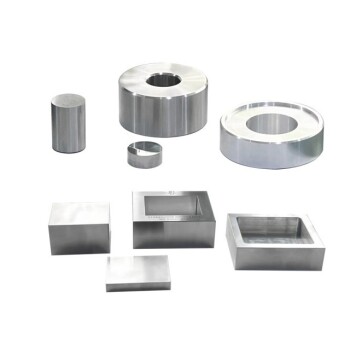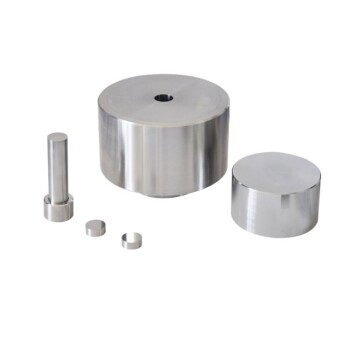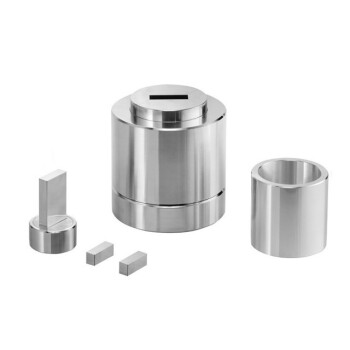In a laboratory setting, the key metric for a hydraulic press is not its internal system pressure but the total force it can apply. While the hydraulic fluid itself may be pressurized to around 1,000 psi, the critical specification is the output load, which typically ranges from 2 to 40 tonnes (approximately 4,400 to 88,000 pounds of force). This force is then concentrated over a small area to generate immense pressure on a sample.
The essential takeaway is not the maximum force a press can generate, but rather understanding which force is appropriate for your specific scientific application. Choosing the right press is a matter of matching its capabilities to your goal, whether that's routine sample preparation or high-stress materials testing.
The Role of Force in Laboratory Applications
The broad force range of laboratory presses reflects their use in two distinct primary functions: preparing samples for analysis and testing the physical limits of materials. The force required for each is significantly different.
Application 1: Sample Preparation for Analysis
For many analytical techniques, such as FTIR (Fourier-Transform Infrared Spectroscopy) or XRF (X-ray Fluorescence), the sample must be prepared in a specific way to ensure accurate results.
A hydraulic press is used to compress powdered material, often mixed with a transparent medium like Potassium Bromide (KBr), into a thin, uniform pellet. The goal is consistency and optical clarity, not maximum force.
For this purpose, a force of 7 to 10 tonnes is often the ideal range. It's enough to create a solid, transparent pellet without fracturing it.
Application 2: Materials Science and Testing
In materials science, the objective is different. Researchers use presses to study how materials deform, compact, or fail under extreme conditions.
This involves testing the compressive strength and stress-strain behavior of substances. These applications demand much higher forces, often pushing into the 20 to 40 tonne range of the most powerful laboratory presses.
Here, the goal is to subject the material to a controlled, high-stress environment to measure its fundamental properties.
Understanding Key Trade-offs
Simply choosing the press with the highest force rating can be a mistake. The effectiveness of a press depends on control and suitability for the task.
The Pitfall of "More is Better"
Applying excessive force during sample preparation is counterproductive. For an FTIR pellet, too much force can cause the pellet to crack or become opaque, rendering it useless for analysis. It can also cause premature wear on the press and its dies.
Manual vs. Automated Presses
Manual presses are simpler and less expensive, relying on an operator to pump a handle to build pressure. They are sufficient for many tasks but lack repeatability.
Automated presses allow the user to set a target force. The press applies and holds that force precisely, ensuring every sample is prepared under identical conditions. This is critical for reproducible scientific results.
Force vs. True Pressure (PSI/MPa)
It is crucial to distinguish between the force the press applies (in tonnes or kN) and the pressure the sample experiences (in psi or MPa).
Pressure is defined as Force per Unit Area. A 10-tonne force applied to a small 13mm diameter die creates a much higher pressure than the same force applied to a large 30mm die. Understanding this relationship is fundamental to controlling your experiment.
Making the Right Choice for Your Goal
To select the appropriate equipment, align the press's capabilities with your primary research objective.
- If your primary focus is reproducible sample preparation (e.g., FTIR, XRF): A press in the 10-15 tonne range is ideal, and an automated model will provide superior control and consistency for better results.
- If your primary focus is materials strength and behavior testing: Prioritize a higher-force press (20-40 tonnes) and ensure its frame and safety features are designed to handle high-energy compression events.
By focusing on the force required for your specific application, you ensure accurate, repeatable results from your laboratory press.
Summary Table:
| Application | Typical Force Range | Key Considerations |
|---|---|---|
| Sample Preparation (e.g., FTIR, XRF) | 7-10 tonnes | Ensures uniform pellets without cracking; automated presses recommended for repeatability |
| Materials Science and Testing | 20-40 tonnes | Used for compressive strength and stress-strain analysis; requires robust safety features |
Ready to enhance your laboratory's precision and efficiency? KINTEK specializes in high-quality lab press machines, including automatic lab presses, isostatic presses, and heated lab presses, designed to meet your specific needs in sample preparation and materials testing. Our equipment ensures accurate, repeatable results, saving you time and improving data quality. Contact us today to discuss how our solutions can benefit your research!
Visual Guide

Related Products
- Laboratory Hydraulic Press 2T Lab Pellet Press for KBR FTIR
- Manual Heated Hydraulic Lab Press with Integrated Hot Plates Hydraulic Press Machine
- Automatic Laboratory Hydraulic Press Lab Pellet Press Machine
- Manual Laboratory Hydraulic Press Lab Pellet Press
- Laboratory Hydraulic Press Lab Pellet Press Button Battery Press
People Also Ask
- What is the purpose of making KBr pellets in the lab? Achieve High-Sensitivity FTIR Analysis for Accurate Results
- How is a laboratory hydraulic press used in sample preparation for FTIR spectroscopy? Create Transparent Pellets for Accurate Analysis
- What is the overall significance of hydraulic presses in laboratories? Unlock Precision and Power for Your Research
- How do hydraulic press machines ensure precision and consistency in pressure application? Achieve Reliable Force Control for Your Lab
- What are some laboratory applications of hydraulic presses? Boost Precision in Sample Prep and Testing



















